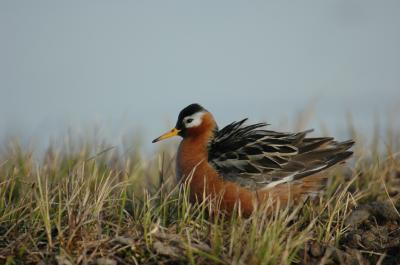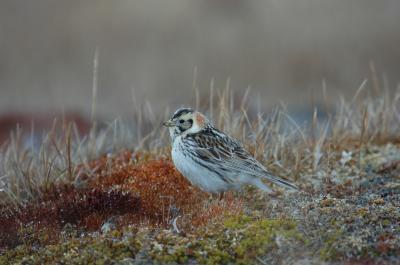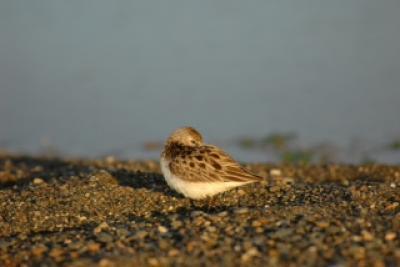Our internal circadian clock regulates daily life processes and is synchronized by external cues, the Zeitgeber, with the main cue being the light-dark cycle.
But the light-dark cycle effect is largely reduced in extreme habitats such as in the Arctic during the polar summer. Using a radiotelemetry system a team of researchers from the Max Planck Institute for Ornithology have now found, in four bird species in Alaska, different daily activity patterns ranging from strictly rhythmic to completely arrhythmic. These differences are attributed to the species' mating systems and behaviors. Their study shows that activity patterns can change according to social and environmental factors, which suggests a remarkable plasticity in the avian circadian system.
Biological rhythms are essential for the regulation of many life processes. During the annual cycle, seasonal rhythms regulate the timing of reproductive activities. In our latitudes this a relatively easy task, as the marked annual changes in a day-night cycle (the photoperiod) entrains the seasonal clock.
At the equator, where there is almost no change in day length over the year the animals have to rely on cues other than the photoperiod to time reproduction. However, in order to adjust its circadian clock an organism needs a certain light-dark cycle as a Zeitgeber. In the absence of a suitable Zeitgeber animals run free, which means they develop their own rhythm that can substantially deviate from a 24 hours day.
Free-running cycles have been observed in animals and humans. Polar regions constitute extreme environments in this respect, as there is, around the summer and winter solstices, either constant light or constant darkness. Therefore, animals living in these harsh environments may have to depend on other cues in order to adjust their internal clock. These cues are relatively hard to determine.

The red phalarope is polyandrous, i.e. one female simultaneously lives with several males. It tries to woo and dazzle potential partners with a display flight. Credit: Wolfgang Forstmeier
An attempt to identify such cues has been made by a team of researchers from the Max Planck Institute for Ornithology in Seewiesen and Radolfzell. They investigated four bird species living in Alaska; three shorebird species, the semipalmated sandpiper, the pectoral sandpiper, the red phalarope, and one songbird species, the Lapland longspur.
Remarkably, all four species have different mating systems. While the semipalmated sandpiper is strictly monogamous, the Lapland longspur, in addition to its monogamous lifestyle, shows occasional polygyny, where one male mates with several females. Polygyny is the rule in the mating system of the pectoral sandpiper, while the red phalarope is polyandrous, i.e. one female simultaneously mates with several males. Moreover, in the latter species the sex roles are reversed.
The study site was on a two square kilometer tundra area near Barrow in Northern Alaska. The researchers equipped in total 142 birds with radiotelemetry transmitters and determined their daily activity patterns using so-called actograms.

The Lapland longspur breeds across Norway, Sweden, and Northern Russia. In the summer, the birds feast on the swarms of midges that visit the Tundra in the summer months. In the winter, their diet consists of plant seeds. Credit: Wolfgang Forstmeier
When analyzing the activity data the researchers detected a whole array of biological rhythms. The Lapland longspur exhibited a robust 24 hour activity cycle throughout the breeding season and showed a regular but short resting period from about midnight to 4:00 am. However, in the shorebirds, depending on sex and breeding stage, there was either a robust 24 hour rhythm, or continuous activity and "free-running" circadian rhythms.
But why are there such different activity patterns within the same habitat? A closer look at the "lifestyles" of the investigated species provided an explanation. Although all these species are migratory and are entrained to a regular light-dark regime in their wintering and stopover sites, during the short breeding season of the Arctic summer, they have to cope with extreme environmental conditions. Food availability could be a major factor in entraining the 24 hour cycle found in the Lapland longspur and in the care-giving sexes of the two polygamous species during incubation.
This showed a higher nest attendance at night as there are marked daily fluctuations in ground temperature with "nights" being very cold. Further, no insects were available at night and continuous incubation is necessary to prevent the eggs from cooling off. On the other hand, male pectoral sandpipers are almost continuously active.
This intense wakefulness pays off as it was shown that the most active males sired the most offspring. In the monogamous semi-palmated sandpiper with bi-parental care, there is evidence of social synchronization as both breeding partners exhibited the same "free running" activity pattern during the incubation period. Our comparative study revealed that the avian circadian system can be entrained by environmental as well as social factors within a short period in the Arctic summer, which suggests a remarkable plasticity, says Bart Kempenaers, head of the research team.

This image shows a semipalmated sandpiper. Credit: Wolfgang Forstmeier




Comments